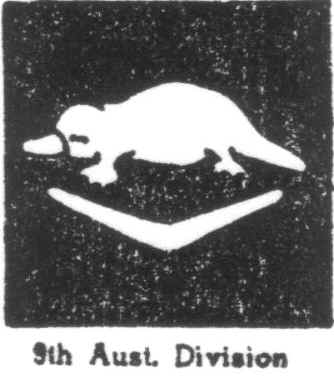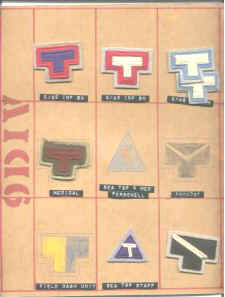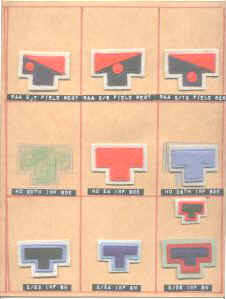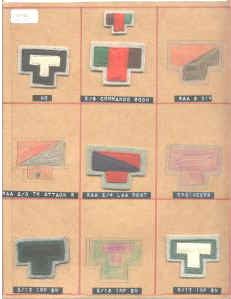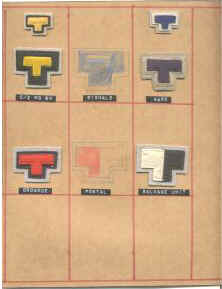 |
|
|||
|
|
||||
| 9th Australian Infantry Division | 20th Brigade | 24th Brigade | 26th Brigade |
| Battalions: | 2/13th, 2/15th, 2/17th | 2/28th, 2/32nd, 2/43rd | 2/23rd, 2/24th, 2/48th |
|
Many tributes were paid to the Division, but what many would regard as the ultimate tribute was paid some considerable time later-on 6 June 1944 (D Day), when the Allies landed in Normandy. With the freedom of the world at stake, Major-General Francis de Guingaund, Chief of Staff of Field Marshal Montgomery's Land-force Headquarters, said: "My God, I wish we had 9th Australian Division with us this morning". |
9th Australian Infantry Division -
Raised May to October 1940
|
|
|
|
|
Colour patches of the 9th Division after they were allowed the honour of the "T" shaped patch to recognize their service at the Siege of Tobruk. |
|
|
|
|
The Ninth Division, Second AIFThe 9th Division was the fourth new infantry division raised by the Australian army after the outbreak of World War Two. The first two, the 6th Division (formed in September 1939) and the 7th (March 1940) were dispatched to Palestine, in the Middle-East, to complete their training before joining the British Expeditionary Force (BEF) in France. Together they formed the 1st Australian Corps, 2nd AIF. However, events overtook them, and France fell to the Germans in July 1940 before the Australian Corps arrived. This highlighted the seriousness of the situation in Europe, and Australia immediately undertook to raise two further infantry divisions and an armoured division for Imperial service overseas. These were the 8th and 9th Infantry Divisions, and the 1st Armoured Division. Further Militia divisions were established for home-defence. The 9th Division was first formed in the United Kingdom during 1940, using one of the 6th Division units, the 18th Brigade, as its core. A second Brigade was formed from other Australian units then in Britain. Major General H.D.Wynter was appointed as commander. Some shuffling of component units occurred, and by early 1941, when it arrived in North Africa the 9th Division consisted of the 20th, 24th and 26th Brigades. In February of 1941 Major General Leslie Morshead became commander. North AfricaIn March 1941 the 9th was ordered up to the front line at Marsa Brega, on the Gulf of Sirte in Libya. This was the furthermost point west that the Allied forces had advanced in pursuit of the retreating Italian Army. The 20th Brigade (composed of the 2/13th, 2/15th and 2/17th Battalions) was initially posted to this front line, but because it was so exposed, was withdrawn to safety by Morshead just before the Africa Corps offensive opened on the 31 of March 1941. The entire 9th Division began to withdraw eastwards toward Tobruk in good order before Rommel's offensive. During this withdrawal the Australian's first battle with German forces occurred - between the 2/13th Battalion and Africa Corps armoured units, just east of Benghazi, on 4 April. Later, some troops from the 2/15th Battalion were captured near Mechili, but the bulk of the division was safely entrenched in Tobruk by the 11 of April 1941. They were ordered to hold the town until relieved by a force from Egypt. Little did they know that the 9th Division would be besieged until October, and that its last unit in Tobruk, the 2/13th Battalion, would not be relieved until the siege was finally lifted in December. This latter battalion was involved in the heavy fighting east of Tobruk immediately before Rommel finally withdrew his forces westwards. The 9th Division suffered heavy causalities at Tobruk - amounting to 832 men killed, 2177 wounded and 941 captured. Tobruk was the first place that the German Army had been beaten, and became a ray of hope for all the Allied nations. Indeed, the overall war situation was still extremely serious for the Allies, but Tobruk gave some hope. The Division was withdrawn to Syria to rest and re-equip, and was still there when it learned of the later surrender of Tobruk after Rommel's second strike eastwards in June 1942. As Rommel closed to El Alamein the 9th Division was moved forward into Egypt and positioned inside the Egyptian border for defence of Alexandria, being then less than 100 miles from this important city. However, Rommel's forces were in a difficult supply situation and the El Alamein line became the scene of fierce, but static battles. The 9th Division was involved in most of this fighting between July and September 1942, with casualties exceeding 2,500 men. On 23 October Montgomery open the Allied offensive at El Alamein. The 9th Division, along with a New Zealand, a South African, an Indian and a British division, grouped as the 30th Corps, formed the main attack in the north. This attack was designed as a feint to draw Axis forces northward away from the planned main breakthrough point of the British 10th Armoured Corps. The fighting lasted for ten days with Brigades of the 9th Division in the van. Gradually the main force of the Africa Corps was drawn northwards to counter this fierce fighting. The initial attack of the British Armoured force further south, failed to break the Axis line. Then the New Zealand 2nd Division attacked to the left of the Australians, and forced the opening through which the Armoured divisions of the Eighth Army finally rolled forward. They did not stop again until the surrender of all of North African Axis forces in Tunis in May 1943. The casualties of the 9th Division in the El Alamein battles equalled those of the entire British 10th Armoured Corps which was tasked with the breakthrough. Montgomery's first act after the battle was seen to be won, was to travel to 9th Division HQ and thank them for their redemption of the initially-failed 10th Armoured Corps attack. The commander of 30 Corps stated that the El Alamein breakthrough was "only made possible by the 9th Division's Homeric fighting". The PacificBy early 1943 the 9th Division was back in Australia. It was stationed with the 7th at Atherton in North Queensland, and training for the jungle fighting against the Japanese yet to come north of Australia. Together they were formed into the 11th Australian Corps, with the entire Corps being under the command of Lt.General Morshead, the 9th Division's experienced North African commander. On 4 September 1943, the lead Brigade of the 9th Division (20th Brigade with 2/13th, 2/15th and 2/17th Battalions) landed near Lae on the northern New Guinea coast. Lae was quickly captured, and the 9th advanced to Finschafen and Sio on the Huon Peninsula. On 21 January 1944, the division handed over to the Australian 5th Division at Sio. They had suffered 1028 casualties (including 283 men killed) since landing at Lae in September. In May 1945 the Division was again in action, this time in Borneo. The 26th Brigade invaded Tarakan Island on the east coast to create a base for supporting operations elsewhere in Borneo. Fighting was fierce and the Australians suffered nearly 900 causalities. The balance of the 9th Division (the 20th and 24th Brigades) went ashore at Labuan Island and Brunei on the north-west coast of Borneo on 10 June 1945. The opposition was sporadic, but sometimes determined, and when the Japanese surrender on 15 August 1945 ended the fighting in Borneo, the 9th division had suffered 114 men killed during this final campaign. |
